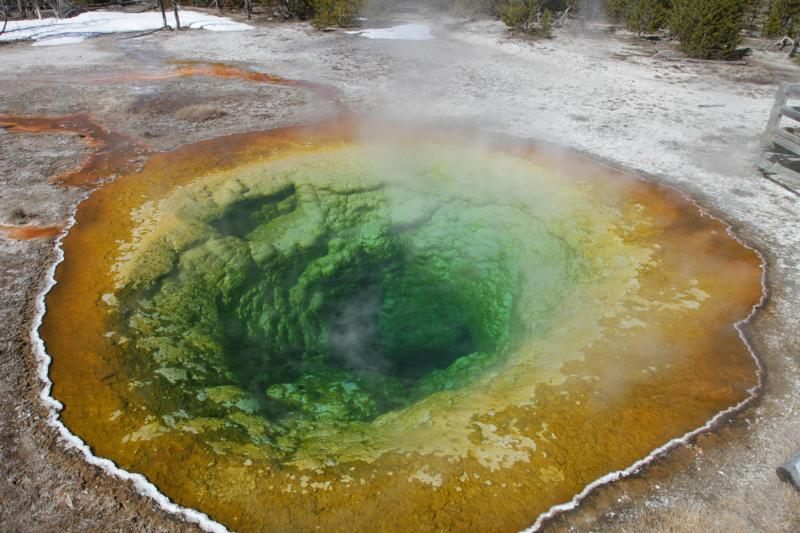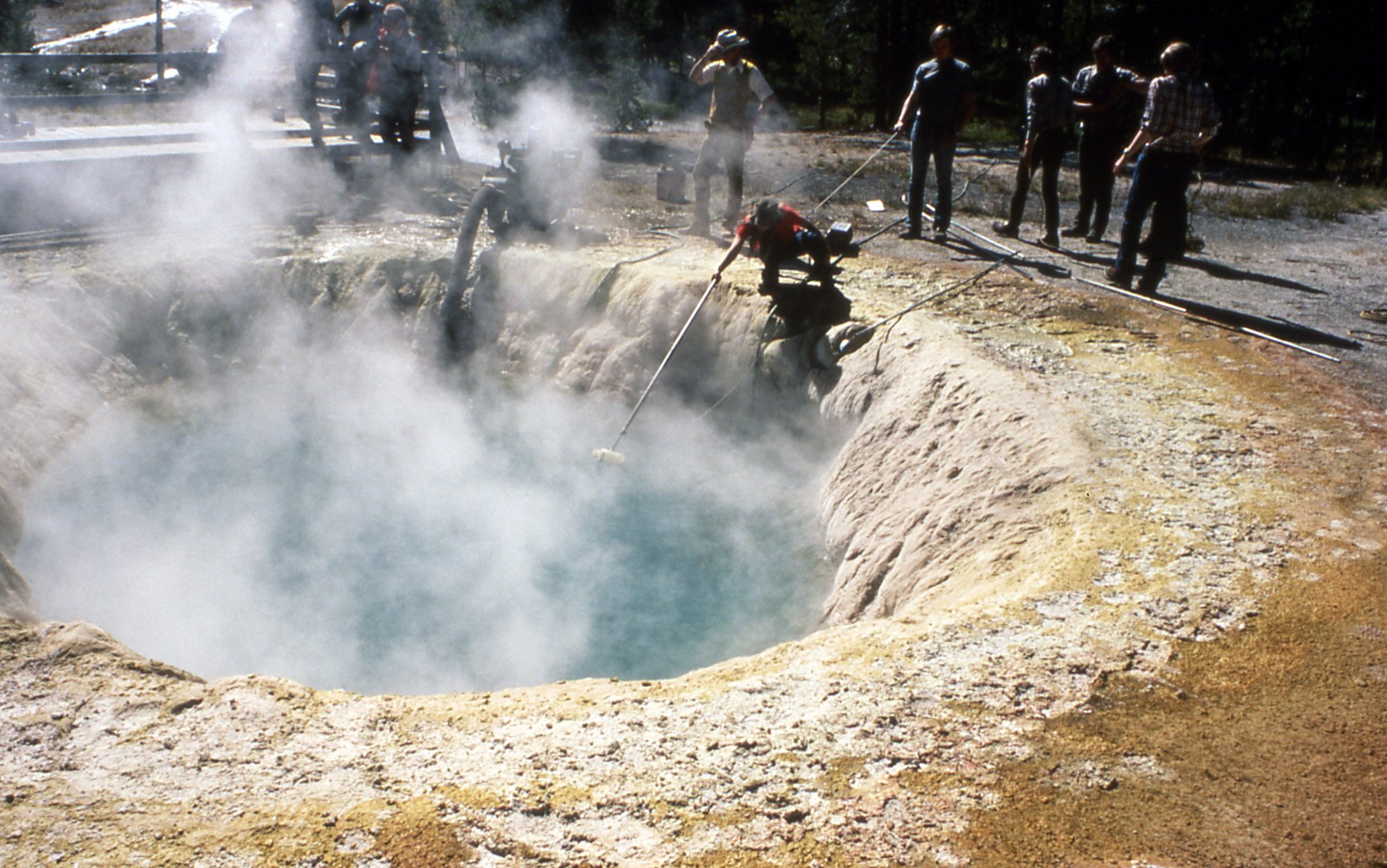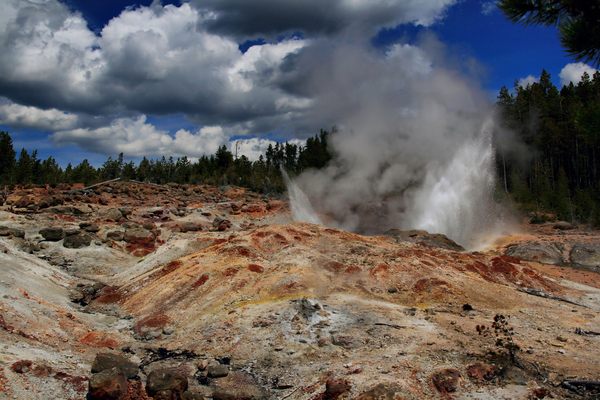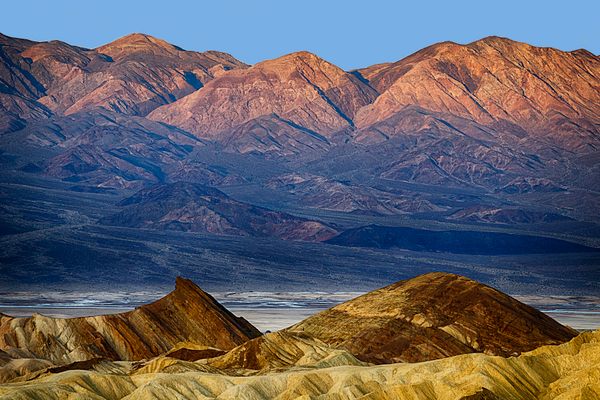The Embarrassing History of Crap Thrown Into Yellowstone’s Geysers
Laundry, horseshoes, coins, and the collective decency of humanity.

When it comes to geothermal features, Yellowstone National Park holds an embarrassment of riches. Located largely inside the massive caldera of an ancient volcano, the park is home to thousands of geysers and hot springs, including Old Faithful and the Grand Prismatic Spring. But of course humans just can’t have nice things, and pretty much ever since Yellowstone’s one-of-a-kind geysers and pools were first discovered, people have been throwing shit into them.
Yellowstone does not keep a centralized inventory of the things they have found in their geysers and pools, but related stories go back to before the National Park Service even existed. Yellowstone National Park was established in 1872, and it was originally the Army’s responsibility to protect it. But as it turned out, the military wasn’t overly concerned with making sure geysers were left alone. In the early days of the park, that mostly meant laundry.
Yes, one of the most famous tales from that era is that an early expedition party used Old Faithful as a washing machine. According to an account shared by Frank D. Carpenter in his record of a trip to Yellowstone in 1877, The Wonders of Geyser Land, he and his traveling companions came upon Old Faithful and decided to experiment with “boiling” their clothes clean. The group put their soiled clothes in a pillowcase and threw it into the geyser’s cone. When it erupted, the clothes were sent flying over a hundred feet into the air. When they collected them, the churning, heated water had indeed cleaned them.

Emboldened by the results of their laundry experiment, they then clogged the geyser with “at least a thousand pounds of stones, trees, and stumps.” The geyser expelled all the rubbish and debris they’d choked the feature with, and they seemed pretty happy. As Carpenter says, “[Old Faithful] furnishes entertainment of unusual magnitude and duration.”
While representatives from Yellowstone could not confirm Carpenter’s account, that wasn’t the end of the park’s laundry experiments. “Soap was one of the things that visitors in the early days put into the geysers,” says Yellowstone spokeswoman Linda Veress. In the 1880s, it became a popular practice to throw soap into the geothermal features, where it would create a sort of film on the surface. The sudsy activity eventually became so popular that hotels and gift shops couldn’t keep bars of soap in stock. One ill-fated entrepreneur even tried to start a little laundry service using one of the seemingly dormant hot springs as a wash basin. “According to the park historian Lee Whittlesey, he carelessly dropped a cake of soap into the tub and a short while later, up went the clothes and the tent,” says Veress.
As park oversight and protections evolved over the years, especially with the advent of the National Park Service in 1916, such large-scale “experiments” pretty much died away. But visitors, the number of which also increased dramatically over the years, have never stopped throwing things into Yellowstone’s colorful wonders. “By the ’50s people had thrown so much trash, rocks, and coins into the Morning Glory Pool that it became informally known as the ‘Garbage Can,’” says Veress. The Morning Glory Pool is a vibrantly colored hot spring in the Upper Geyser Basin, which got its name from the original blueish hue of its waters. Today, the delicate chemical composition of the pool has been forever altered by the things that tourists have tossed into it. “Over the last 150 years, because of people throwing stuff in there, the orange and yellow bacteria that once lived only in the coolest periphery of the spring have spread toward the center as the internal plumbing was fouled,” says Veress.
Objects can also clog up the works, turning once-active geysers and spouters into still ponds. Take the case of Handkerchief Pool, once as famous as Old Faithful. “It stopped functioning some time in the 1920s or ’30s,” says Veress. “It stopped because people threw coins, broken bottles, rocks, hairpins, and a small horseshoe into it about a hundred years ago.” In recent decades the pool has shown more activity, but still remains largely forgotten despite its location near Old Faithful, in one of the most heavily trafficked portions of the park.
Attempts have been made to clean debris from Yellowstone’s features, but the process is complicated due to the extreme temperatures of geothermal waters, the depth and intricacy of natural plumbing, and the simple fact that efforts to clean or “fix” the features run the risk of doing additional damage. Currently there are only around four specialists on the park’s staff who handle cleaning things out of the ponds and geysers when the need arises.
According to The Geysers of Yellowstone, in 1950, Morning Glory was artificially induced to erupt in an effort to clean the trashed pond. The result is said to have blown out all sorts of items including bottles, cans, underwear, 76 handkerchiefs, and $86.27 in pennies.
Even today, after the practice of tossing things into Yellowstone’s features has been made officially illegal (“Fines for intentionally throwing items in the features can be up to six months in jail and up to $5,000,” says Veress), people still continue to treat the geothermal wonders like trash cans and wishing wells. “Coins are a popular thing that people throw in. Food items, cigarette butts,” says Veress.

But it’s not all trash. Despite all the modern rules and regulations put in place to protect Yellowstone’s delicate natural wonders, people just can’t manage to stop throwing their junk into them. “In 2014, a visitor from the Netherlands crashed a drone into the Grand Prismatic Spring,” says Veress. “Drones are prohibited in all national parks. It was recovered but not returned.”
Today, it seems self-evident that we shouldn’t be tossing junk into delicate natural wonders, but for anyone who might still think it’s no big deal, Veress puts it pretty simply. “I would say don’t do it,” she says. “I would say that along with the increased visitation, all it takes is one person throwing one thing in there to spur on others to do it too.”


















Follow us on Twitter to get the latest on the world's hidden wonders.
Like us on Facebook to get the latest on the world's hidden wonders.
Follow us on Twitter Like us on Facebook